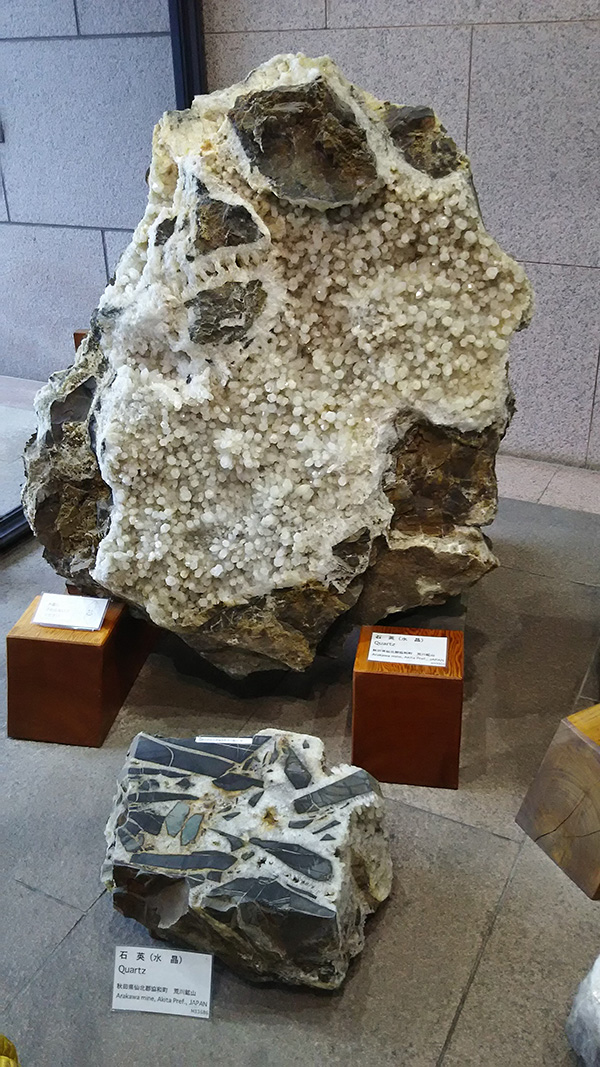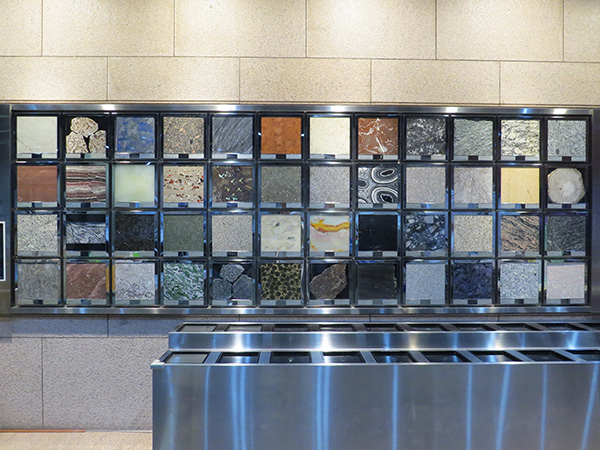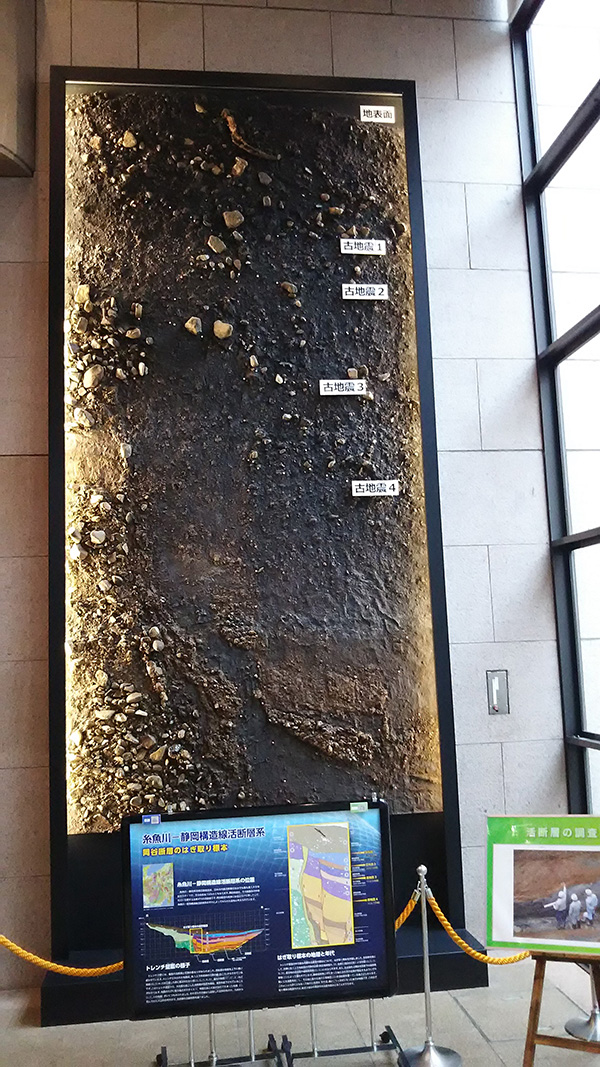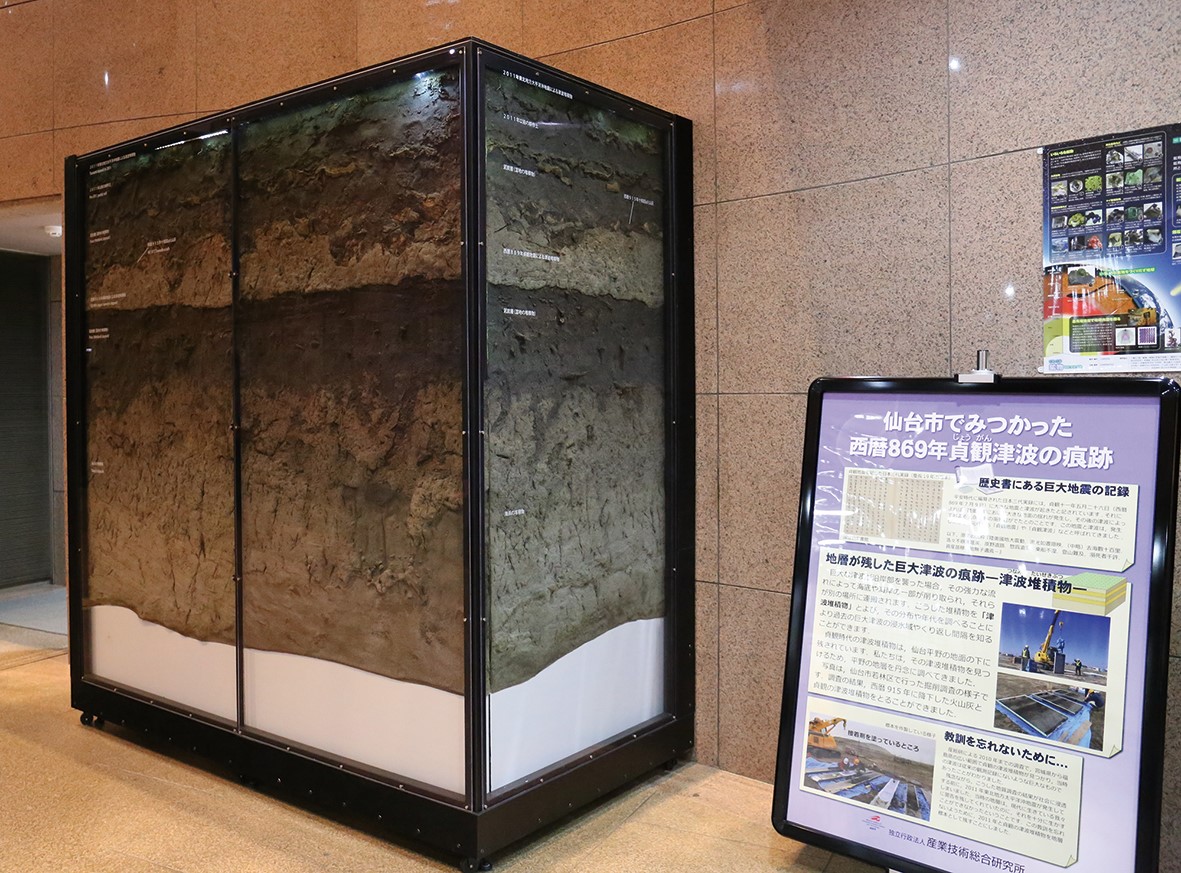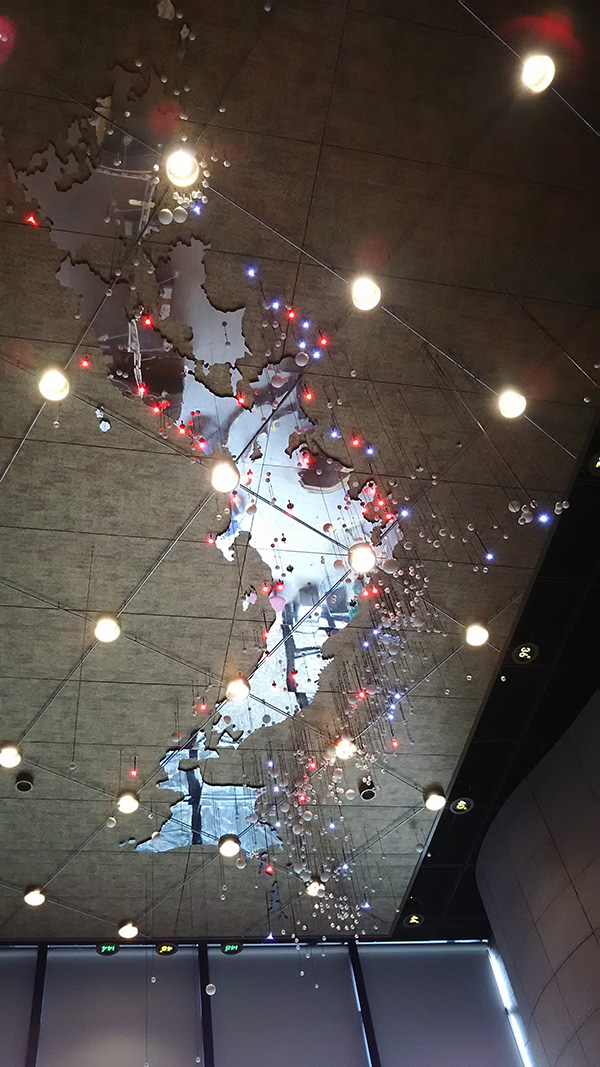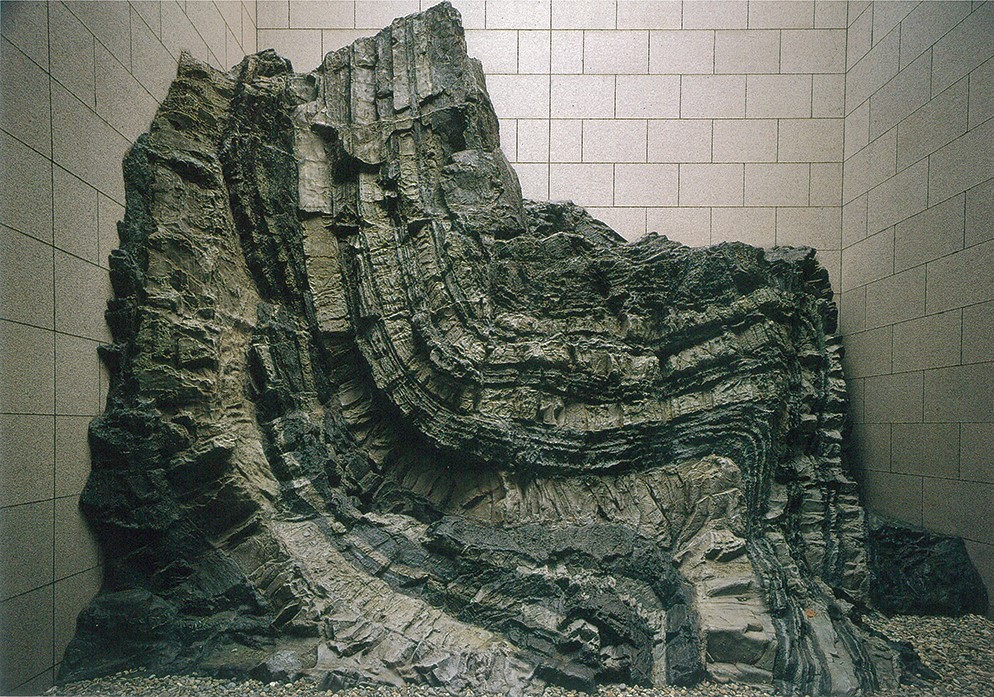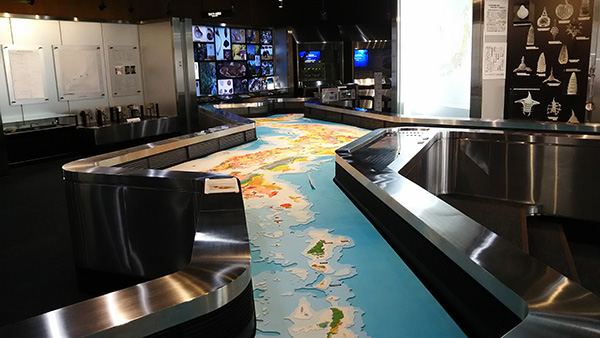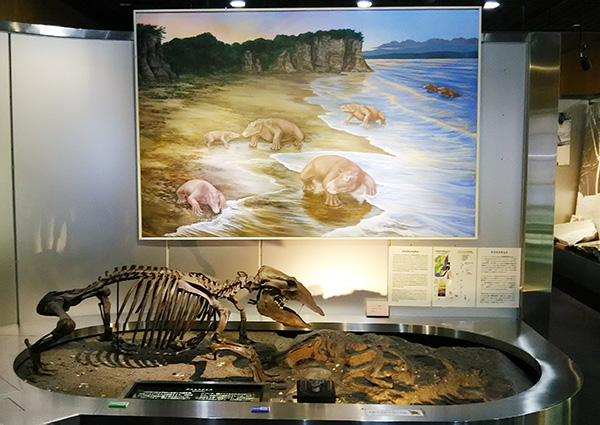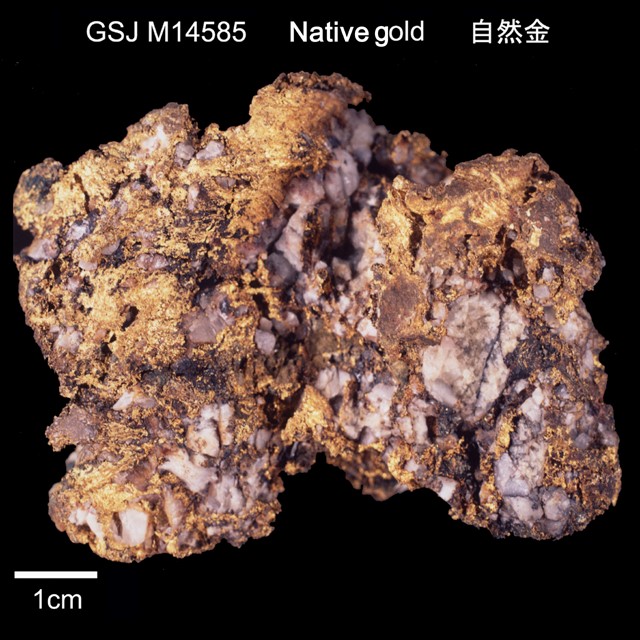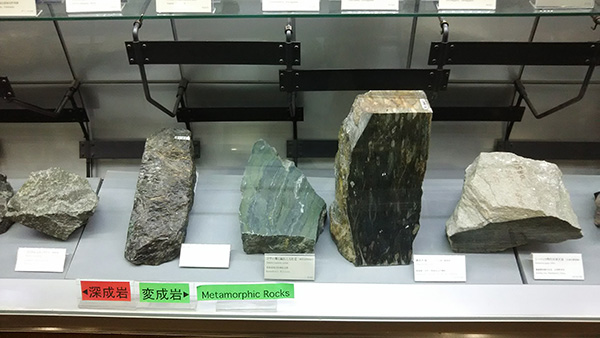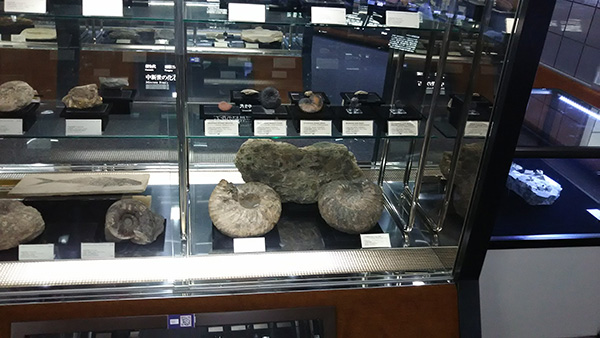1st Floor
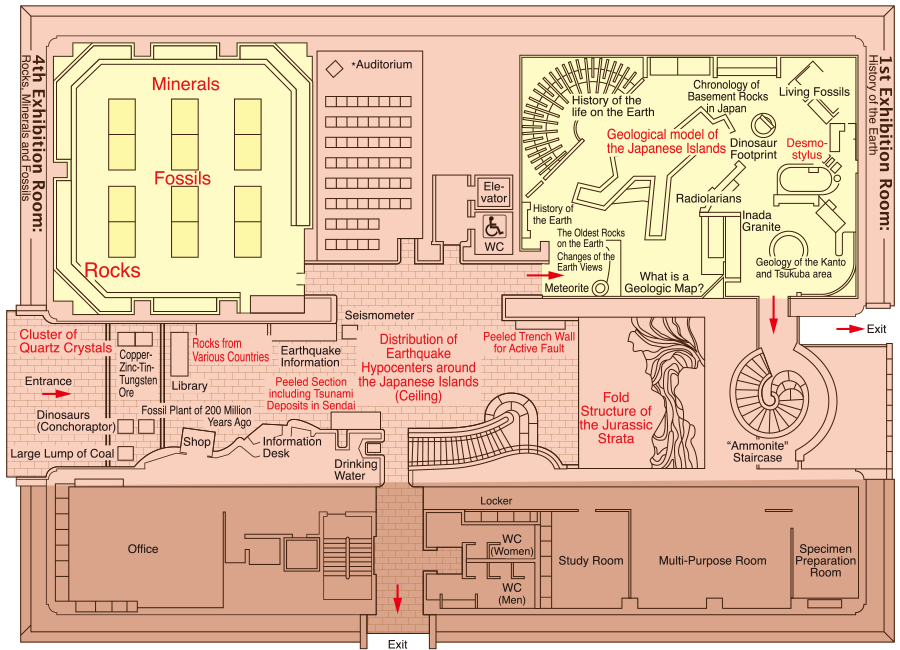
1st Floor:Entrace Hall, 1st and 4th Exhibition Rooms
click red texts to show guides
Entrance Hall
Cluster of Quartz Crystals
This specimen is a cluster of quartz crystals from the Arakawa mine, Akita Prefecture. The Arakawa mine was one of the most productive copper mines in Japan. Although the mine was closed in 1940, fine quartz crystals were collectable from the old mine dumps and the outcrops until 2007. The specimen exhibited was collected in 1998 from a large pocket in a quartz vein developed in the dark grayish host rock.
Rocks from Various Countries of the World
The Geological Museum was opened in August, 1980. At the time, we received gifts in the form of many rock plates from a number of geological research centers and comparable national institutes worldwide. Forty eight of these plates are being exhibited on the wall to the left of the Museum’s entrance. Each exhibit is labeled with the name of the specimen, together with the name of the institute donated it. All are examples of geological characteristics unique to the countries of their origin. The specimens include rocks not found in Japan. A few of the exhibits are fossil specimens. Please take closer look, and just imagine how varied the geological characteristics of the earth’s surface are.
Peeled Cross Section of an Active Fault
An “active fault” is a fault that has caused -- and is likely to continue causing -- earthquakes repeatedly. To assess the potential for earthquake generation of an active fault, it is necessary to shed light on its past activities.
This is a peeled cross section from a trench excavation of the Okaya Fault in Nagano Prefecture, a part of a central portion of the Itoigawa-Shizuoka Tectonic Line active fault system. The left side of the panel is west, and the right side east. There are displacements along the two almost vertical faults on the lefthand side of the panel, along which the eastern side has moved downward. The top of these faults are covered with the surface layer, and it is evident that the most recent event occurred before its deposition. From detailed analysis of the fault displacement pattern and dating the deposition of the strata, it has been confirmed that there have been four earthquakes within the last 7,200 years. From this exhibit, we can see evidence of the two most recent events.
Peeled Section including Tsunami Deposits in Sendai
The 2011 Tohoku Earthquake caused enormous tsunami damages to an extensive area of the Pacific coast of eastern Japan. This is a peeled cross section of strata beneath the Sendai Plain that was taken after the earthquake using the Geoslicer technique. The ground surface is covered with the tsunami deposit from the Tohoku Earthquake. The sand layer between the two black peat layers is also a tsunami deposit. Volcanic ash immediately above it is identified as being from the 915 eruption of the Towada volcano. Taking this into account, together with the results from dating the peat layer beneath it, this tsunami deposit is thought to be from the 869 Jogan Earthquake, which is documented in “Nihon Sandai Jitsuroku”, one of the ancient writings of Japan.
Distribution of Earthquake Hypocenters around the Japanese Islands
On the ceiling is a map of the Japanese Islands as looked up from the interior of the Earth. The white balls suspended from the ceiling represent the hypocenters of earthquakes of magnitude 6 or greater that occurred between 1926 and 1976. The length of the string is proportional to the depth of the hypocenters. The white lights indicate major earthquakes of magnitude 7.5 or greater. The earthquake hypocenters tend to lie at shallower depths along the Pacific coast and at greater depths toward Japan Sea. The hypocenters of disastrous earthquakes since 1847 are shown in red lights on the ceiling.
Fold Structure Model of the Jurassic Strata
Through the glass window at the end of the hall, you can see a "cliff" showing intensely folded strata. This is a plastic replica of a cliff in Ojika Peninsula, Miyagi Prefecture, northeastern Japan. The outcrop is composed of alternating beds of sandstone and mudstone of the Jurassic Period of Mesozoic Era (ca. 150 million years ago). The strata was tectonically deformed about 100 million years ago to form fold structure as you see in the model of cliff.
1st Exhibition Room
Geological Model of the Japanese Islands
The 3D geological model of the Japanese Islands scaled down to 1/340,000th of its original size is in the center of the 1st exhibition room, and its terrain has been exaggerated to three times its original height. You can hear the Japanese explanations concerning the geological characteristics of each regional area and the main tectonic lines by pressing the button(s) on the panel. The Itoigawa-Shizuoka Tectonic Line, which bisects Japan from east to west, and the Median Tectonic Line, which similarly bisects southwestern Japan from north to south, are clearly marked. Please compare the variation in topography of places where old rocks and sediments are, and where younger sediments have spread by referring to the legend; a color chart showing the geology according to rock types and geological ages.
Desmostylus
Desmostylus is a extinct mammal (not a dinosaur) that lived along the portions of northern coast of the Pacific Ocean between 23 million and 11 million years ago. This specimen was discovered in a fossiliferous sandstone bed of the Neogene Period in Utanobori, Esashi-cho, Hokkaido. Desmostylians are characterized by their back teeth shaped like cylindrical pillers bunched together. It is believed that they used the back teeth to consume clams and seaside grasses.
4th Exhibition Room
Minerals
In the 4th exhibition room, approximately 350 mineral specimens are systematically displayed based on chemical compositions. This systematic exhibit, the most complete one in Japan, includes excellent mineral specimens from the Japanese mines most of which have already been closed. One of the most remarkable specimens in this exhibit is the biggest native gold nugget in Japan (362.5 g) from the Shishiori mine, Miyagi Prefecture. World-famous, giant stibnite crystals from the Ichinokawa mine of Ehime Prefecture are also noteworthy. The displayed specimen is an aggregate of columnar crystals with sword-like terminations. Single, columnar crystal of gypsum from the Udo mine, Shimane Prefecture, reaches 73 cm in length, the largest crystal of this kind in Japan. World-class crystals of deep-red, pyroxmangite from the Taguchi mine of Aichi Prefecture also attract attention.
Rocks
Rock specimens are also kept in glass cases along the wall. In this exhibit are shown 136 rock types commonly found in Japan. They are sedimentary rocks, volcanic rocks, plutonic rocks and metamorphic rocks, arranged from the shallower part of the crust to greater depths.
Fossils
Approximately 600 fossils, mostly from Japan, forms this exhibit. The fossil specimens are housed in the central glass cases, and are arranged in a chronological order. The Paleozoic fossils are mostly corals, fusulinids, brachiopods and trilobites, which are important in determining the geological age of the Paleozoic strata. The rock sample of the oldest stratum in Japan is displayed near the entrance of this room. The sample was collected at Hitoegane, Gifu Prefecture of central Japan, containing Ordovician conodonts, microfossils found in strata of the Paleozoic to the early Mesozoic eras. The Mesozoic fossils include the important index fossils such as ammonites and bivalves (e.g., Monotis, Trigonia, and Inoceramus). The Cenozoic fossils are mostly bivalves, gastropods (snails), fishes, and plants. You can touch the replica of a large tooth of the fossil elephant: the original fossil was discovered at Hanamuro River near this museum.

